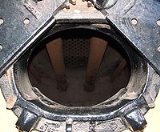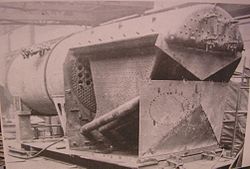
Thermic syphon
Encyclopedia

Steam locomotive
A steam locomotive is a railway locomotive that produces its power through a steam engine. These locomotives are fueled by burning some combustible material, usually coal, wood or oil, to produce steam in a boiler, which drives the steam engine...
designs. As they are directly exposed to the radiant heat of combustion, they have a high evaporative capacity relative to their size. By arranging them near-vertically, they also have good water circulation by means of the thermosyphon effect.
The concept of a self-circulating thermic syphon began with stationary boilers and relatively simple Galloway tubes. They reached their peak in steam locomotive boilers, where the complexity of a syphon was justified by the need for a compact and lightweight means of increasing boiler capacity. One of the best known forms for locomotives was invented and patented Thermic siphon for locomotives - Patent 1679051 by the American locomotive engineer .American locomotive engineers The Nicholson form combined a complex shape that provided more heating area in a given space than did the earlier tubes and funnels, yet was simple to make, being folded from a single sheet of steel.
A thermic siphon is an integral part of the boiler and is quite different from a feedwater heater
Feedwater heater
A feedwater heater is a power plant component used to pre-heat water delivered to a steam generating boiler. Preheating the feedwater reduces the irreversibilities involved in steam generation and therefore improves the thermodynamic efficiency of the system...
, which is an external accessory.
Flued boilers
The first high-pressure boilers were a large drum with a central flue, such as the Cornish and Lancashire boilers. Simple tubes were inserted across this flue.Steam locomotives

Funnel
A funnel is a pipe with a wide, often conical mouth and a narrow stem. It is used to channel liquid or fine-grained substances into containers with a small opening. Without a funnel, spillage would occur....
-shaped steel fabrication that connects the bottom of the throat sheet (the front wall of the firebox) with the crown sheet (the roof of the firebox). Feed water flows upward through the siphons from the boiler barrel. By exposing the water to the heat of the firebox, thermic siphons increase thermal efficiency and help to improve water circulation in the boiler through ensuring more uniform temperatures within it. Fresh cold water introduced from the injector
Injector
ʎ̩An injector, ejector, steam ejector, steam injector, eductor-jet pump or thermocompressor is a pump-like device that uses the Venturi effect of a converging-diverging nozzle to convert the pressure energy of a motive fluid to velocity energy which creates a low pressure zone that dɯaws in and...
s is pre-heated by passage through the siphons before arriving at the crown sheet, the hottest part of the boiler. Thermic siphons are located in the body of the firebox or, if applied, in the combustion chamber. The technique has been utilised on several designs. In Great Britain
Great Britain
Great Britain or Britain is an island situated to the northwest of Continental Europe. It is the ninth largest island in the world, and the largest European island, as well as the largest of the British Isles...
, the principal advocate of this technology
Technology
Technology is the making, usage, and knowledge of tools, machines, techniques, crafts, systems or methods of organization in order to solve a problem or perform a specific function. It can also refer to the collection of such tools, machinery, and procedures. The word technology comes ;...
was Oliver Bulleid
Oliver Bulleid
Oliver Vaughan Snell Bulleid was a British railway and mechanical engineer best known as the Chief Mechanical Engineer of the Southern Railway between 1937 and the 1948 nationalisation, developing many well-known locomotives.- Early life and Great Northern Railway :He was born in Invercargill,...
, with the concept used in his Merchant Navy
SR Merchant Navy class
The SR Merchant Navy class , was a class of air-smoothed 4-6-2 Pacific steam locomotives designed for the Southern Railway of the United Kingdom by Oliver Bulleid...
, Leader class
SR Leader Class
The Leader was a class of experimental 0-6-6-0T articulated steam locomotive, produced in the United Kingdom to the design of the innovative engineer Oliver Bulleid. The Leader was an attempt to extend the life of steam traction by eliminating many of the operational drawbacks associated with...
, West Country and Battle of Britain Classes.

